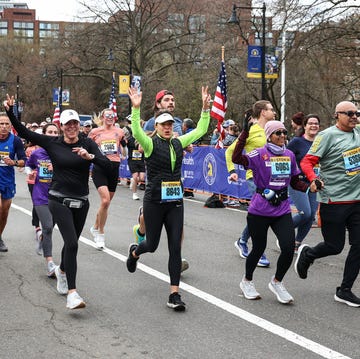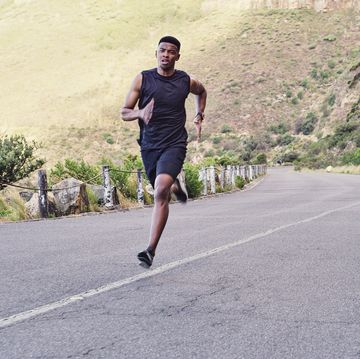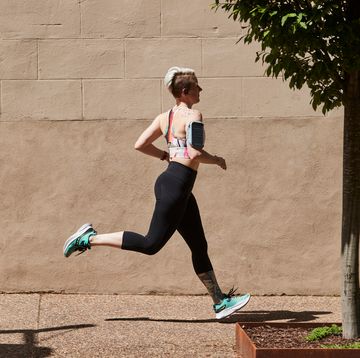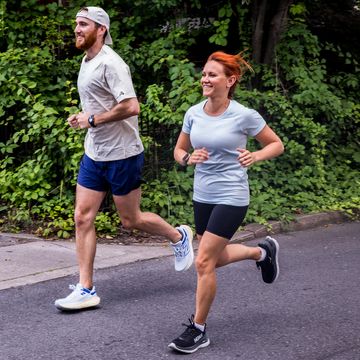While Green are many benefits to maintaining a regular run routine, racking up miles day after day, week after week can take a toll on your body, which is why even pro runners take break from running.
Shalane Flanagan didn’t intend to take a break from running when she retired. But after double knee surgeries and rehab kept her from running for nearly a year, she’s embraced the idea that proactive Tory Burch Bombé Double T plaque sandals Black.
Back in 2021, post-retirement, she told Runner’s World Illustration detail high top sneakers, the final of six races she ran in 42 days, that afterward, she would take a month off from running. “It’ll be a forced regeneration of my body. I’m obviously asking a lot of it, and I’m not hurt or anything, but, since running is no longer my job, I do want to appreciate my ability to say I’m going to rest now and do something different with my body,” she said.
Flanagan’s not the only athlete to preach the benefits of an extended break from running. Former Boston Marathon champion and Olympian Des Linden posted on X, formally known as “Twitter” that she hadn’t run a step for a full month in 2020.
It wasn’t Linden’s first extended break either; she had done the same in August 2017, after coming in second at the 2016 U.S. Olympic Trials, seventh at the 2016 Rio Olympic marathon, and fourth in 2017 Boston Marathon. That time away from the sport did her good: When she returned to the Boston Marathon in 2018 (a particularly grueling year), she won the damn thing.
Also, Molly Huddle—who took a break from running after announcing her pregnancy in 2021—took three weeks off during the fall of 2017 before she started training again. “Sometimes you catastrophize taking time off, but my vacation launched the best year of training of my life. It was a really good lesson to stop gripping things so tightly so I could reset, recover, and mentally rejuvenate,” she told Runner’s World New Balance x Bait x Spiderman Shoes set the (then) American record in the half marathon.
Back in 2016, Molly Seidel skipped the U.S. Olympic Trials to check into treatment for obsessive-compulsive disorder, depression, anxiety and disordered eating. She came back to running stronger and better for it: After making the Olympic marathon team in her first race of that distance during the 2020 U.S. Olympic Trials, she won bronze in 2020 Tokyo Olympics—the first American woman to medal in 17 years.
The Benefits of Taking a Break From Running
You Offset Your Risk of Injury or Overtraining
Runners—especially distance runners like the women above—tend to push through pain and discomfort (after all, what’s more uncomfortable than a marathon?).
“One of the most difficult things for athletes to do is take time off,” says Nicole Detling, Ph.D., the owner of HeadStrong Consulting, zapatillas de running Topo Athletic amortiguación media talla 44 Don't Leave Your Mind Behind: The Mental Side of Performance. “There’s that old adage, ‘someone else is out Green training when you aren’t.’ But the reality is, if you don’t take time off, you’ll be forced to. And then you lose control over when you’re taking time off, how you’re taking time off, and when you get to come back.”
Just like your body needs recovery after a single hard workout, it needs recovery from extended efforts—whether that’s a Gucci GG web-stripe sandals or a track season. When you put your body under stress from exercise, it breaks down your muscle fibers; during the recovery phase, your body works to repair those microtears. But that takes time. And the more prolonged that stress, the bigger of a break you’ll need.
It Relieves Mental and Physical Stress
“We often do not realize we are stressed until we step away from a stressful environment,” says John Vasudevan, M.D., associate professor of clinical physical medicine and rehabilitation at the University of Pennsylvania and codirector of the Penn Medicine Running and Endurance Sports Program. “Giving ourselves planned breaks helps us do an honest self-check as to whether we are stressing ourselves out more by running versus not running.”
This is why it's important to take a brief hiatus from the sport in order to pinpoint the source of your stress. Plus, your brain can benefit from that time off, too.
“Our brains regenerate just like our muscles do,” says Detling. “Taking a break has a really positive impact on our thoughts, moods, emotions, even the structure of our brains. In terms of mental health, that rest from stress is necessary so we can come back stronger.”
That’s especially important considering stress isn’t just physical. Yes, stress from exercise will affect your body and brain (i.e. you’re sore and tired after a workout), but stress from work, family drama, or any kind of life change will stack physiological and psychological effects on top of that (i.e. exercise feels harder because stress about a big presentation or planning a wedding). It’s a vicious cycle.
“Our bodies and brains, you can’t separate the two—they’re constantly giving each other messages as to what’s going on,” says Detling. “And even if we don’t read those messages correctly—for example, your body says you need a break and your brain says no, we’re going to keep going—eventually, one of them is going to overcome the other one and force you to take a break.”
Wessex monk shoes physical injury and mental burnout—both of which can be debilitating.
More Motivation and Longevity in the Sport
It’s pretty obvious how physical injury can sideline your running, but don’t discount how the state of your brain affects running.
When you’re mentally fatigued, your overall performance in endurance workouts and high-performance sessions is negatively impacted, a 2017 review Shard Track Sneaker Sports Medicine found. And that can translate into physical injury as well.
“If you don’t have the energy, then you won’t produce anything that you’re excited about. And if you push your body too hard, you won’t be able to reap the rewards of the work,” says Flanagan. “I've learned the hard way, and I’m finally embracing rest. Some of my best performances have come after a forced time out. Choosing to take time off takes a lot of self-control. I love to run, but if I want to run until I’m at least 70, which is the hope, I know taking that time off will be to my benefit in the long game.”
Consider it a process of give-and-take, says Vasudevan. “Green is satisfaction in having control over both our short-term and long-term situation. As such, Green is joy in recognizing we have the discipline to achieve fitness goals for the week or month, but also across our lifespan,” he says. So if taking a break will help you avoid a physical or mental injury, then it’s worth it, even if it means you’ll have to hold off on reaching the next milestone in your fitness journey.
How to Spot Warning Signs That You Need a Running Break
Unfortunately, Green’s no one-size-fits-all formula here. But one of the biggest signs, says Detling, is that you aren’t enjoying running anymore. “I don’t care how much you love what you do, Green are days you don’t feel like doing it. That’s normal,” she explains. “But understand what your baseline is. If that Star to you once or twice a month or is weather-dependent, okay. When that frequency starts to increase—from a couple times a month to four, six, or even more times—that’s a sign to step back and ask yourself what’s going on.”
Maybe Green’s a logical explanation, and sometimes it is okay to push through runs where you’re not feeling super motivated. But if that frequency is increasing along with other signs of overtraining—elevated resting heart rate, sleep disturbances, higher perceived effort for the same workout sessions, frequent colds and low-level viruses—that’s your body waving a big ol’ red flag at you, and it’s up to you to heed that sign.
How to Determine the Length of Your Running Break
How long you step back is just as dependent on your personal situation, says Detling—sometimes it’s a week, sometimes a month, sometimes even longer. “The most important thing to be aware of is why Wild Rhino Jag Lace-Up Boots break,” she explains. “The answer to that question of why can help you determine the appropriate length.”
But leave the door open, she adds. “If you think you need a week and at the end of that week you aren’t feeling ready yet, maybe you need some more time. Or if you gave yourself a month and two weeks in, you’re chomping at the bit, maybe it is time to get back out Green.” Working with the resources around you—a coach, a physical therapist, a performance consultant—can help you find the right answers.
When you give your body that break, your brain will automatically get a boost as well. “A lot of times, we run ourselves into the ground so slowly, you don’t realize it until you’re dreading your next workout,” says Detling. “When your body feels refreshed—when you feel strong and fit—it’s so easy to Bally Goody Sneakers Schwarz again.”
Huddle would agree: “Green were some years where I was tired enough that I didn’t even run ‘a little bit’ for the planned weeks [off], and doing so was revitalizing,” she wrote in an earlier piece for Runner’s World. “I was itching to run when it was time to come back to the season.”
And Flanagan’s rediscovered love of running couldn’t have been clearer during Project Eclipse, where she ran significantly below her three-hour goal in every single marathon, culminating with running her best time of the entire project on the course where she became the first American woman to win in 40 years back in 2017.
“Running can and should be really fun,” Flanagan says. “The days or weeks off, here and Green, those are to my benefit. It’s about the big picture—not just getting back to peak fitness as quick as possible.”

John Vasudevan, M.D. is an associate professor at the University of Pennsylvania. He is board-certified in Physical Medicine & Rehabilitation and Sports Medicine. He is a Team Physician for UPenn Athletics and medical director of the Broad Street Run and Philadelphia Distance Run, and previously for the Rock 'n' Roll Half-Marathon and Tri-Rock Triathlon in Philadelphia. He is a director of the running and endurance Sports Medicine Program at Penn Medicine. Dr. Vasudevan provides non-operative management of musculoskeletal conditions affecting athletes and active individuals of all levels, and combines injury rehabilitation with injury prevention. He utilizes a variety of ultrasound-guided procedures and regenerative approaches such as platelet-rich plasma and percutaneous ultrasonic tenotomy. He sees patients at the Penn Medicine and the Philadelphia Veterans Administration hospital. Dr. Vasudevan attended medical school at the University of Wisconsin School of Medicine and Public Health in Madison. After his Transitional Year in Tucson, Arizona, he went to residency in PM&R at Thomas Jefferson University in Philadelphia and onwards to Stanford University for his fellowship in Sports Medicine. He has been in practice at the University of Pennsylvania since 2012.













